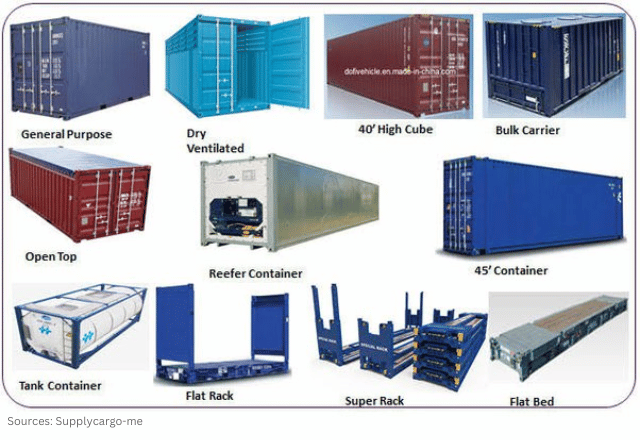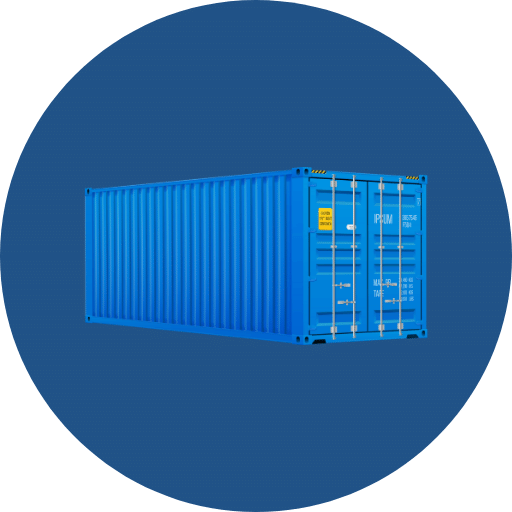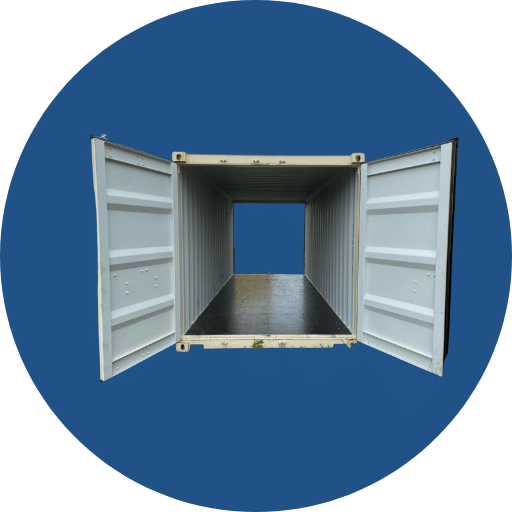
Ever found yourself pondering about those big, boxy structures known as shipping containers? Maybe you’re considering buying one for your next big project. Or it could be you’re just fascinated by these gigantic symbols of global trade and wonder what on earth differentiates one from another.
Whatever’s sparked your interest, you’re in the right place!
We’re digging into everything shipping-container related – from highlighting the different types, sizes, and shapes, to exploring the incredible ways they’re used both in businesses and personal ventures.
Are you ready? Let’s dive right into the wonderful world of shipping containers!
The Common Types of Shipping Containers
#1. Dry Storage Containers

Dry Storage Containers are loved by folks needing to transport non-perishable items. They come in a versatile range of sizes from 10′ to 48′, making them a ridiculously practical option for loads of different cargo volumes. One of the best things about these bad boys is that they’re totally weatherproof. So, come rain, shine, or snow, your stuff is going to stay safe and sound, even on those super long hauls.
But it’s not just their weatherproof nature that makes these containers a great choice. They’re also built to last, with strong lashing rings that keep your cargo nice and secure during transit. So, no matter whether you’re shipping by rail, road, or sea, you can be confident that your goods are going to turn up just as you sent them.
Best of all, Dry Storage Containers won’t break the bank. They’re priced super reasonably, which makes them a manageable solution for personal and industrial storage needs. Honestly, given their durability, versatility, and cost-effectiveness, it’s no wonder that Dry Storage Containers are a top pick in the shipping and storage industry.
Common Size:10′, 20′, 40′, 45′, 48’
Price Range: $1300 -$3000.
Usage: Include general cargo transport, industrial storage, personal or home storage, and motor vehicle storage.
Advantages: The cool part about these containers is that they’re pretty cheap and can be used for a bunch of different things. They can carry a load of stuff, they’re completely waterproof, and their set sizes make them super easy to transport on various types of vehicles.
#2. Double Door Containers

Double Door Containers are pretty legit – they’re made from tough stuff like steel or aluminum, so you can trust your cargo is secure. Each one comes with standard size doors, lock boxes for added security, and certifications from official bodies. Moving your cargo gets a whole lot easier, as these containers hit all those important quality and safety standards. If you’ve got loads of stuff to ship or store, these containers are a solid choice.
Common Size: 20ft and 40ft
Price Range: $1,900 – $2,450; Additional costs for double doors: $400 – $600
Usage: General Cargo Transport, Large Project Sites, Equipment and Machinery Storage, Retail and Inventory Storage.
Advantages: Ease of access, enhanced loading/unloading efficiency, cost-efficiency for certain applications due to dual entry, and secure cargo doors on both ends.
#3.Tank Containers

Tank containers are real lifesavers when it comes to storing and moving a variety of stuff like liquids, chemicals, or even food items. Coming in standard sizes like 20ft or 40ft, they offer flexibility for different needs.
The coolest part? They’re way more efficient than dealing with a ton of smaller drums – talk about a logistical nightmare! Plus, they’re super easy to load, unload, and ship, making them a smart pick for a lot of different jobs. So, whether you’re in the food industry, dealing with chemicals, or anything that involves large amounts of liquids, tank containers can really streamline your operations.
Common Size: 20ft and 40ft ISO tanks
Price Range: $10,563.76 – $12,190.34
Usage: Storage or bulk transportation of liquids, chemicals, food items including groceries, wines, spirits, organic juices, sweet oils, synthetics, harmful substances, and gases
Advantages: More productive than using smaller drums; easy to ship; quick load and unload through rooftop lids and valves; secure and protected method of shipment.
#4. Flat Rack Containers

Ever attempted to move or store bulky, heavyweight items like machinery or vehicles? Trust me, it’s no picnic. That’s unless you have a flat rack container on your side. These bad boys are designed with collapsible sides – think of a Transformer in shipping container form – making them perfect for just about any hefty item you need to transport or store.
These containers aren’t just about brute force, though. They’re packing a serious versatility punch too. Flat racks can be loaded and unloaded from the side or top, which is a major game-changer when you’re dealing with items that won’t play nice with a traditional loading dock. Got to unload something at a hectic port? Easy.
Need to work with a crane on a busy construction site? No sweat. Forklift, gantry crane, or even old-school manual labor – flat rack containers can handle it all.
And here’s the cherry on top: when you’re not using those big, sturdy sides, they fold down neatly. That means you can stack empty containers together, saving you a bunch of space during transport or storage. And let’s be honest, who doesn’t love saving space, especially when it comes to freight and logistics?
So, to sum up the mighty flat rack container, they’ve got your back on easy loading and unloading, flexibility for all your odd-sized objects, and the potential to save huge amounts of space. Whatever daunting task you have in mind, these containers are ready to step up to the plate and make life a whole lot easier.
Common Size: 20′ and 40
Price Range: $4,200 to to $11,900.
Usage: Suitable for heavy loads and cargo that requires loading from the top or sides, like pipes and machinery.
Advantages: Easy to load and unload with various methods, like from the top using a crane or from the side using a forklift. It is versatile, allowing for the transportation of a wide range of goods. Collapsible walls provide flexibility in cargo dimensions. Strong construction, capable of carrying more weight compared to ordinary containers.
#5. Open Side Containers
Open Side Containers are a versatile powerhouse for all kinds of uses. They come in a range of sizes, so they can handle whatever you need, from massive items to bunches of smaller stuff stacked neatly. But what really makes them stand out from the crowd is how much you can customize them. You can tweak these bad boys down to the smallest details to make them perfect for whatever project you’ve got in mind.
And don’t get it twisted, these containers aren’t just for shipping. It’s like they’re the Transformers of the container world, morphing into mobile shops or temporary offices. They’re all about adaptability, toughing it out on transit journeys and then settling down to serve as solid, static spots for whatever you need.
In fact, these containers are starting to make waves in the real estate sector. They’re being reimagined as pop-up shops, quirky cafes, and event spaces. They’re the new hip things at food markets, music festivals, and other public hangout spots. Whether it’s for storage, transportation, or creating a cool, new space, these containers are doing it all. Believe me, your imagination’s the only limit!
Common Size: 20-foot and 40-foot sizes
Price Range: $1,900 to $8,000,
Usage: Ideal for transportation of large or varied cargo, storage of diverse items with easy partition installations, and modifications into pop-up shops, cafes, homes, offices, etc
Advantages: Large doors make loading and unloading open-side containers easy. They can be easily customized, making them ideal for mobile shops, homes, and offices.
#6. Reefer (Refrigerated) Containers
Ever thought about how our fruits and veggies stay fresh during their long journeys from farm to table? Well, that’s all thanks to Reefer containers. They’re the behind-the-scenes rockstars of global trade. Known as refrigerated containers, these boys are specifically crafted to ship temperature-sensitive items—fruits, veggies, even pharmaceuticals. Basically, anything that needs to be kept chill. They’re like huge refrigerators that maintain a steady, cool temperature.
So, whether your items are trudging through a burning desert or crossing a frosty ocean, they’ll arrive as fresh as they were the moment they left.
Quite cool, huh?
Common Size: 20-foot size
Price Range: $3,000 to $7,000
Usage: They transport temperature-sensitive goods like fruits, vegetables, pharmaceuticals, and other perishables safely and securely.
Advantages: They are designed specifically to maintain the integrity and safety of perishable goods like fresh produce, medicines, and other perishables while in transit.
#7. High Cube Containers
Standing tall at 9.5 feet, High Cube Containers are not your average shipping equipment. These towering structures offer an added one and a half feet of vertical space compared to the standard 8-foot containers. And this extra room is far from just being a nice-to-have – it’s a game changer. Ever thought of turning a shipping container into a home, office, studio or workshop? These containers make that possible and more! With High Cube Containers, you won’t feel cramped in your new container-turned-loft, workshop or storage area.
High Cube Containers don’t just bring in extra space, they also pack a punch in the durability department. Thanks to their corrugated steel construction, these containers can withstand anything from harsh weather to rough treatment. So, if you’re thinking of transforming one into a permanent structure, you can trust that it’ll be strong and stable. It’s this mix of size and toughness that’s propelling High Cube Containers to be the top choice for a lot of building conversions all over. From cool pop-up shops to modern offices, these containers are reshaping how we view architectural design and space efficiency.
So, if you’re on the hunt for a storage solution that doesn’t restrict your space, or you’re eager to dip your toes in the thrilling realm of container homes or offices, you should really check out High Cube Containers. With a price range of $2,000 to $8,000 and typical sizes of 20ft and 40ft, they’re an accessible and adaptable option that offers you a world of possibilities to explore
Common Size: 20ft and 40ft
Price Range: $2,000-$8,000
Usage: Storage, housing, offices, shops, Pools, bars, studios, Garages, toilets, shelters.
Advantages: Durable, secure, movable, Affordable, quick to build, Custom sizes available.
#8. Open Top Containers
Open top containers solves this problem by being specifically designed for top-loading. It’s a game changer to how easy it is to load and unload cargo using different equipment, including conveyor belts, cranes or shovels. They are designed with the utmost precision to ensure you can maximize your cargo space with no hassles.
These helpful containers are found in standard 20ft and 40ft sizes. You might be wondering, why these sizes only? Well, it’s all about standardization in the shipping and logistics world. With these sizes, stacking, handling, and transportation becomes a breeze. No matter the mode of transport – be it by sea, rail, or truck, you can bet that it will fit snugly.
Open top containers aren’t just about practicality, they also offer durability. Thanks to their high-quality rugged materials, they can stand up to the challenges of long-distance shipping ensuring that your cargo remains safe and secure. It’s obvious then, investing in an open top container isn’t just practical, it’s a smart move! So, the next time you have stuff that’s oversized or oddly shaped to ship, you know which container has your back.
Common Size: 20ft and 40ft sizes
Price Range: $2,000 – $4,000
Usage: Shipping loose cargo like coal, gravel, scrap metal, or oversized cargo that needs extra height clearance.
Advantages: Easy top access for loading/unloading, increased interior height.
Other Shipping Containers Types
The other less common shipping container types include insulated, ventilated, Half-Height, swap body, bulk, car carrier, pallet wide, hardtop, drum, and tunnel.
Frequently Asked Questions
Yes, shipping containers can be repurposed for various applications, such as housing, offices, storage facilities, and even restaurants.